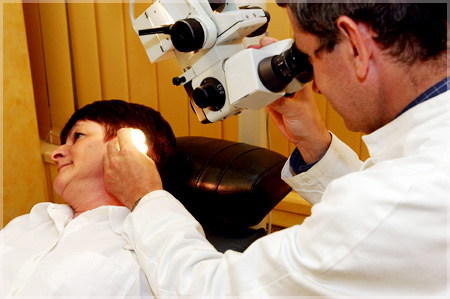 1. Cochlear Implant: 1. Cochlear Implant:
A cochlear implant (CI) is a surgically implanted electronic device that provides a sense of sound to a person who is profoundly deaf or severely hard of hearing. Cochlear implants are often referred to as a bionic ear.
2. Bone Anchored Hearing Aid:
A Bone-anchored hearing aid is a type of hearing aid based on bone conduction. It is primarily suited to people who have conductive hearing losses, unilateral hearing loss and people with mixed hearing losses who cannot otherwise wear 'in the ear' or 'behind the ear' hearing aids.
3. Stapedotomy:
A stapedectomy is a surgical procedure of the middle ear performed to improve hearing.
If the stapes footplate is fixed in position, rather than being normally mobile, then a conductive hearing loss results. There are two major causes of stapes fixation. The first is a disease process of abnormal mineralization of the temporal bone called otosclerosis. The second is a congenital malformation of the stapes.
4. Facial Nerve Decompression:
Facial nerve decompression is an operation that is done on patients who have complete paralysis of the face usually following trauma or a viral infection such as Bell’s palsy. Patients need to be seen early after the onset of the paralysis in order for the decompression to have a successful outcome. There are different types of facial nerve decompression depending on the location of the problem. Facial nerve decompression often involves a type of craniotomy called a middle fossa craniotomy and may also require a complete mastoidectomy. All of these operations take pressure off the facial nerve and sometimes a facial nerve graft may be required in order to restore long-term function.
5.Tympanoplasty:
Tympanoplasty is the surgical operation performed for the reconstruction of the eardrum (tympanic membrane) and/or the small bones of the middle ear (ossicles).
6. Mastoidectomy with Tympanoplasty:
Tympanoplasty with mastoidectomy is surgery which corrects middle ear problems in both the tympanic membrane (eardrum) and the mastoid bone (bony honeycomb of air pockets located just behind the ear).
7. External & Middle Ear Congenital Anomaly:
Congenital anomalies are the product of errors in embryogenesis (malformations) or the result of intrauterine events that affect embryonic and fetal growth (deformations and disruptions). The more complex the formation of a structure, the more opportunities for malformation.
The formation of the ear involves fusion of ectoderm, endoderm, and mesoderm. Defects in formation may lead to a wide variety of dysfunctional or malformed structures. The embryology, clinical features, and management of congenital anomalies of the ear are reviewed here. Congenital anomalies of the upper respiratory and gastrointestinal tracts are discussed separately.
8. Surgery of Meniere's Diseases:
Meniere's disease is a disorder of the inner ear that can affect hearing and balance to a varying degree. It is characterized by episodes of vertigo, low pitched tinnitus, and hearing loss. The hearing loss has a fluctuating then permanent nature, meaning that it comes and goes, alternating between ears for some time, then becomes permanent with no return to normal function. It is named after the French physician Prosper Meniere, who, in an article published in 1861, first reported that vertigo was caused by inner ear disorders. The condition affects people differently; it can range in intensity from being a mild annoyance to a chronic, lifelong disability.
9. C.S.F.Otorrhoea:
Fracture of the temporal bone may follow trauma to the ear or skull base.
Fractures may be longitudinal - 80% - or transverse - 20%. Transverse fractures are likely to damage the inner ear and facial nerve.
|